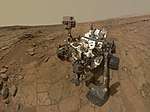Kepler-32
Kepler-32 is an M-type main sequence star located about 1070 light years from Earth, in the constellation of Cygnus. Discovered in January 2012 by the Kepler spacecraft,[5] it shows a 0.58 ± 0.05 solar mass (M☉), a 0.53 ± 0.04 solar radius (R☉), and temperature of 3900.0 K, making it half the mass and radius of the Sun, two-thirds its temperature and 5% its luminosity.[6] It initially was known to have at least 2 planets orbiting around it, the smaller Kepler-32b, orbiting its parent star every 5.90124 days, and Kepler-32c with an orbital period of 8.7522 days.[7] In April 2013, transit-timing variation analysis confirmed 3 other planets to be in the system. However, only very loose constraints of the maximum mass of the planets could be determined.[8]
| Observation data Epoch J2000 Equinox J2000 | |
|---|---|
| Constellation | Cygnus |
| Right ascension | 19h 51m 22.1742s[1] |
| Declination | +46° 34′ 27.390″[1] |
| Apparent magnitude (V) | 16.0[2] |
| Characteristics | |
| Spectral type | M1V[3] |
| Astrometry | |
| Proper motion (μ) | RA: −13.618±0.058[1] mas/yr Dec.: 19.646±0.068[1] mas/yr |
| Parallax (π) | 3.0595 ± 0.0322[1] mas |
| Distance | 1,070 ± 10 ly (327 ± 3 pc) |
| Details | |
| Mass | 0.58±0.05[2] M☉ |
| Radius | 0.53±0.04[2] R☉ |
| Surface gravity (log g) | 4.64[3] cgs |
| Temperature | 3900±200[2] K |
| Metallicity [Fe/H] | 0.00 dex |
| Rotation | 36.220±0.256 days[4] |
| Other designations | |
| Database references | |
| SIMBAD | data |
| KIC | data |
Planetary system
In 2014, the dynamical simulation shown what the Kepler-32 planetary system have likely to undergone a substantial inward migration in the past, producing an observed pattern of lower-mass planets on tightest orbits.[9]
| Companion (in order from star) |
Mass | Semimajor axis (AU) |
Orbital period (days) |
Eccentricity | Inclination | Radius |
|---|---|---|---|---|---|---|
| f | — | 0.013 | 0.742956 | — | — | 0.81±0.05 R⊕ |
| e | — | 0.033 | 2.896009 | — | — | 1.5±0.1 R⊕ |
| b | < 4.1 MJ | 0.05 | 5.90124 | — | — | 2.2±0.2 R⊕ |
| c | < 0.5 MJ | 0.09 | 8.7522 | — | — | 2.0±0.2 R⊕ |
| d | — | 0.129 | 22.780806 | — | — | 2.7±0.1 R⊕ |
References
- Brown, A. G. A.; et al. (Gaia collaboration) (August 2018). "Gaia Data Release 2: Summary of the contents and survey properties". Astronomy & Astrophysics. 616. A1. arXiv:1804.09365. Bibcode:2018A&A...616A...1G. doi:10.1051/0004-6361/201833051. Gaia DR2 record for this source at VizieR.
- "Notes on Kepler-32 b". Retrieved 21 January 2017.
- "KOI-952". SIMBAD. Centre de données astronomiques de Strasbourg. Retrieved 21 January 2017.
- McQuillan, A.; Mazeh, T.; Aigrain, S. (2013). "Stellar Rotation Periods of The Kepler objects of Interest: A Dearth of Close-In Planets Around Fast Rotators". The Astrophysical Journal Letters. 775 (1). L11. arXiv:1308.1845. Bibcode:2013ApJ...775L..11M. doi:10.1088/2041-8205/775/1/L11.
- NBC. "100 billion alien planets fill our galaxy: study". NBC News. Retrieved 28 February 2013.
- Swift, Jonathan J. (2012). "Characterizing the Cool KOIs IV: Kepler-32 as a prototype for the formation of compact planetary systems throughout the Galaxy". The Astrophysical Journal. 764: 105. arXiv:1301.0023. Bibcode:2013ApJ...764..105S. doi:10.1088/0004-637X/764/1/105.
- The Extrasolar Planet Encyclopedia. "Kepler-32". Exoplanet.eu. Archived from the original on 3 February 2014. Retrieved 28 February 2013.
- Fabrycky, Daniel C.; et al. (2012). "Transit Timing Observations from Kepler: IV. Confirmation of 4 Multiple Planet Systems by Simple Physical Models". The Astrophysical Journal. 750 (2): 114. arXiv:1201.5415. Bibcode:2012ApJ...750..114F. doi:10.1088/0004-637X/750/2/114.
- T. O. Hands, R. D. Alexander, W. Dehnen, "Understanding the assembly of Kepler's compact planetary systems", 2014
- NASA Exoplanet Archive--Planet Host Overview page:Kepler-32
Templates


